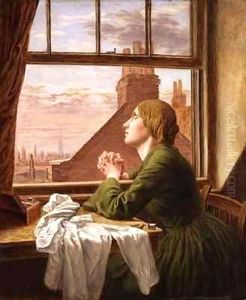Anna E. Blunden Paintings
Anna Elizabeth Blunden, born in 1829, was a notable British artist and member of the Pre-Raphaelite circle, a movement that sought to reform art by rejecting what it considered the mechanistic approach taken by the Mannerist artists who followed Raphael and Michelangelo. The Pre-Raphaelites emphasized a return to abundant detail, intense colors, and complex compositions, which Blunden embraced in her work.
Blunden's journey into the art world began at a young age, influenced by the cultural environment of the Victorian era and the burgeoning Pre-Raphaelite Brotherhood, founded in 1848. Although the Brotherhood was predominantly male, they encouraged and supported female artists, allowing them to take part in the movement. This was a period when the role of women in the professional art world was evolving, and Blunden, among others, was at the forefront of this change.
Throughout her career, Anna Blunden was known for her meticulous attention to detail and her dedication to capturing the essence of her subjects, often focusing on themes of nature, spirituality, and the human condition. Her works were characterized by their vibrant colors, intricate detailing, and emotional depth, aligning with the Pre-Raphaelite ethos of beauty and truth. Despite facing the challenges that came with being a woman in a predominantly male field, Blunden managed to carve out a space for herself and gain recognition for her contributions to the art world.
One of her most recognized works, 'The Blind Girl at the Holy Well' (exhibited in 1856), showcases her skill in using symbolism and natural elements to evoke emotion and tell a story. This painting, like many of her pieces, reflects the Pre-Raphaelite fascination with medieval themes and their attempt to convey moral and spiritual messages through art.
Anna Elizabeth Blunden's legacy extends beyond her paintings. She was part of a movement that challenged the conventions of the time and paved the way for future generations of artists, especially women, to pursue their passion for art. Despite the limited recognition she received during her lifetime compared to some of her male counterparts, her work continues to be appreciated for its contribution to the Pre-Raphaelite movement and its impact on the evolution of British art. Anna Blunden passed away in 1915, leaving behind a body of work that continues to inspire and captivate audiences.
